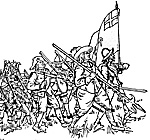
Anyone who has visited Worcester Commandery recently will have seen the animated life-size display depicting the death of the Duke of Hamilton. The common soldier in the diorama, tending the wounded Hamilton, represents an Essex man. [1]
The troops who took Fort Royal were not New Model regulars,
but part-time soldiers from the Essex Trained Bands. Surprisingly -
not least because such provincial militias have habitually been
portrayed by Civil War historians as models of cowardly
incompetence [2] - the Trained
Bands engaged at Worcester fought particularly well.
To a certain extent, seventeenth-century provincial militia
deserved their slovenly reputation. The Trained Bands were part-time
soldiers normally used within their native county to curb civil disorder
and to guard against foreign invasion. In practice, weapons and drill
were often neglected, and attendance at musters falsified by corrupt or
incompetent officials. [3]
Essex's Trained Bands were by no means free of such problems,
although they appear to have been better than most, and were
reasonably well-clothed and armed.
At the outbreak of civil war the Essex Trained Bands declared
their support for Parliament - or, more accurately, loyalty to their
popular Lord Lieutenant, the Puritan Earl of Warwick. [4] However, martial ardour cooled
rapidly as hostilities escalated. Despite statutory exemption from
impressment, an entire regiment was 'lent' to Sir William Waller in
1643. [5] Many men paid
others to take their place, leaving their disgruntled comrades in the
company of unreliable and untrained substitutes.
Far from home, forced to serve 'foreign" commanders, [6] and being paid only the normal
infantry wage of 8d a day rather than their rightful shilling, the
Trained Bands became "mutinous and ungovernable".
Waller declared them "only fit for the gallows here and hell
hereafter", [7] although the
men had been forced to endure an unusually long period away from
home, and even Parliament belatedly acknowledged the mistake of
taking so many away during harvest time. [8] They were permitted to return
to Essex in July 1644.
It would, however, be a mistake to underestimate the fighting potential of provincial militia. [9] The companies of the Essex Trained Bands which defected to the Royalists in 1648 [10] fought well against the New Model at Colchester, whilst those who remained with Parliament proved perfectly adequate. [11] These creditable performances were to be surpassed by their accomplishments during the Worcester campaign.
Political circumstances had changed drastically by 1651. In the
aftermath of the King's execution, the Rump Parliament had reshaped
county committees in its own image. Thus, radicals such as Sir
Thomas Honywood and Joachim Matthews gained ascendancy in
Essex, elbowing aside the traditional county families. Their political
power extended to the control of the county militia: Honywood
commanded the northernmost companies of the Essex Trained Band,
while Matthew and Thomas Cooke took charge of the units based in
southern and middle Essex.
Honywood had already proved his fighting mettle during the
uprising of 1648, but Matthews and Cooke proved no less committed.
Unlike Sir Thomas Barrington, whose regiment had fought so poorly
for Waller in 1643-4, all three would lead their men in person during
the Worcester campaign.
In 1623, the establishment infantry strength was 4,360 men. The numbers appear to have been
significantly smaller in 1651; around 3,000 are thought to have fought at Worcester. Some
companies must have stayed at home to guard against Royalist insurrection while their comrades
marched to Worcester. Other 'missing' militiamen were probably those from the Chelmeford area who had sided with the Royalists in 1648. Needless to say, officers who had turned coat in 1648 were no longer in command of their companies [14]
Peter Young and John Adair have argued convincingly that the crux of Cromwell's 1651 campaaign was to entice the Scots Army of King Charles II into the open, where it could be more easily hunted down and destroyed. [15] Deliberately, therefore, the New Model generals left open a tempting route into England. Charles and the Scots duly obliged, crossing the English border on 5 August.
If Cromwell had envisaged a repeat of his successful Preston campaign of 1648, he was temporarily thwarted; the Scots moved south rather faster than they had three years previously.
Not only did Charles evade dertruction' but on 16 August the Earl of Derby landed in north England with a snall force of Engliah Royalists. Although relatively few English came to join Charles' standard, and more Scots deserted by the day, the longer the young King's army could survive, the greater the risk of general insurrection. Already, former Parliamentarians such as Edward Massey had changed sides, while even Colonel John Birch came to pay his
respects to the King. By the time Charles neared Worcester, Parliament had sent out calls for selected county trained bands to muster and reinforce the New Model Army.
The Essex Trained Bands received orders on 20 August to
rendezvous at Dunstable and there await further instructions. All
three Easex regiments were already moving towards Bedfordshire, as
orders issued the same day appointed Dr. Richard Harlackenden
"Phisitian and Surgeon to the whole Brigade, now upon their march to
the rendezvous at Dunstable". [16] Three senior members of the Essex Committee, including
Harlackenden's kinaman, William, were also ordered to accompany the
militia. [17]
The Essex Trained Bands soon after received orders to march
on Worcester with all possible speed. Several other county militias,
including those from Cheahire, Staffordshire, Suffolk and Surrey, were
also ordered to converge on the city. Charles II reached Worcester on
22 August, and it was soon clear that he intended to fortify the town.
Cromwell's subsequent requeats to Parliament show that he was
preparing for a siege. In the following days, as the Essex and Suffolk
Trained Bands trudged across England, the Earl of Derby's Royalists
were routed at Wigan and Cromwell advanced to within sight of
Worcester. With Lambert approaching from the south, and Robert
Lilburne from the north, Charles II rapidly found himself hemmed in
on three sides.
The Essex and Suffolk forces arrived in the Parliamentarian
leaguer on 31 August. [18]
Praise has been heaped on the New Model Army for the fact that
during the campaign they covered 300 miles in 22 days - an average of
13.6 miles per day. [19] To
reach Worcester via Dunstable only 11 days after receiving their
orders it should be recognised that the part-time soldiers of the Essex
Trained Bands probably out-performed their New Model colleagues.
This pace was too much for some; John Crammer, a husbandman from
Easthorpe, fell sick on the march and had to hire another to take his
place. [20]
With the overwhelming forces now at his disposal, Cromwell
was able to make his final preparations for battle. The Trained Bands,
after their long and tiring march, must have needed a period of rest and
recuperation. It was probably for this reason, rather than superstition,
that Cromwell delayed the final battle until 3 September - his 'lucky'
day. [21]
At home in Essex, many of the godly waited in suspense. On
September 2, the Reverend Ralph Joaselin joined a prayer meeting at
the home of Colonel Thomas Cooke in Pebmarsh: "At Mrs. Cook's in
a day of prayer, at night heard by many hands our friends abroad were
well and that Cromwell was about Worcester and the Scots in it and
their horse in the country round about". [22]
The following day, Josselin journeyed to Markshall, the home
of Sir Thomas Honywood: "Spent this day in prayer at my Lady
Honywood's, much company there, and presence with us, our
expectacions god will advance his glory in our salvation". [23] Their prayers were timely; at
that moment, on the other side of England, Lady Honywood's
husband and the Essex Trained Bands were fighting for their lives.
At dawn Colonel Fleetwood's New Model units had attacked
Powick, just south of Worcester. Eventually, the Scots holding the
village were pushed back in disorder; on their flank, Cromwell himself
had begun to lead more New Model units across assault bridges
thrown across the Severn.
From his vantage point in the tower of Worcester Cathedral,
Charles II could see that Cromwell's concentration in the south had
weakened the Parliamentarian forces covering the eastern defences.
[24] By the afternoon it was
plain that the Royalists were losing the battle. Knowing that their last
chance was to overwhelm Cromwell's weak eastern flank, the
Royalists duly burst out of Sidbury Gate and fell on the six New
Model regiments and the Trained Bands left there.
The Royalist cause was doomed, but three hours of fierce
fighting passed before they were driven back. The Essex Trained
Bands, having fought in the thick of the struggle, were ordered to take
Fort Royal - the formidable bastion which had formerly discouraged
even Cromwell.
Possibly, like Fairfax at Marston Moor, Cromwell thought to
use the inexperienced troops as cannon fodder, rather than waste
seasoned regulars. Surpassing expectations, however, the Essex
Trained Bands "pursued their enemy right up to the mouth of the
cannon" and took the outer defences. [25]
Turning these cannon around into the fortifications,
the Trained Bands began to exact a terrible retribution for their
casualties. Once Fort Royal had fallen, the Royalist retreat became a
rout.
The Duke of Hamilton, his leg broken by cannon shot, was
taken to the Commandery. Legend has it that he died in the room there
now named after him. The Essex Trained Bands, probably with
Honywood's regiment in the van, had taken the building towards the
end of the battle. Thus, the scenario today presented in the
Commandery is entirely credible.
The battle for the city was over. While the militia were resting
and tending their wounded, they were visited by the fiery preacher
Hugh Peter. "When your wives and children shall say to you, where
have you been and what news" said Peter, "then shall you say you
have been to Worcester, where England's sorrows began and where
they have happily ended". [26]
Like Cromwell, Josselin ascribed Parliament's success to God,
noting that the victory had been won "while we were praying at
Markshall."
On September 7, the clergyman wrote in his diary "...heard after the sermon of the taking of Worcester; 6,000 prisoners, 2,000 more slain."
The Trained Bands marched back to Essex almost as quickly as
they had left. On September 14, Ralph Josselin recorded, "our soldiers
returned... went to see Sir Thomas Honywood, who was very well".
[27] On 9 October a grateful
Essex Committee issued orders to bestow gratuities on the militia
engaged at Worcester. [28]
For those who had emerged from the battle unscathed, the Civil
Wars had indeed ended happily. Others were less lucky; for those
who had been maimed, or families newly widowed and orphaned,
life promiaed little but hardahip and misery.
Those among the militia who had been lightly injured presumably
accompanied the Trained Bands on their march home, while the more
badly wounded were carried to the Savoy military hospital in London.
The care afforded by the Savoy and its sister hospital at Ely House
was fairly good by contemporary standards and most
Parliamentarians sent there survived their wounds. Inmates from the
New Model were required to contribute towards medicines and
bandages out of their pay, although it is unclear how the treatment of
wounded militia was funded.
On 1 December 1651, three invalids from Honywood's Regiment,
Christopher Ellin, [29]
Henry Levitt [30] and
Thomas White, [31] had
recovered sufficiently to be discharged from the Savoy. Each clutched
a printed certificate, issued by the Treasurers for Maimed Soldiers,
and a handful of shillings to finance the journey back to their Essex
homes. [32] There, they
faced a different kind of battle from the one in which they had fought
at Worcester.
Although Parliament did attempt to provide financial support
for maimed soldiers, such succour was sometimes erratic and usually
inadequate. Those who could not work for their living relied
principally on the support of their family or the parish. Many,
however, were obliged to petition the county Justices of the Peace for
financial help. Christopher Ellin appeared before the Justices in
Chelmsford at the Easter Quarter Sessions of 1652, pleading that the
musket ball he had received in the arm at Worcester had prevented him
from resuming his trade as a blacksmith.
"Being lame of the wound... he is not able to worke of his
Calling for a Subsistance having a wife and a Childe to maintayne". It
is not recorded what, if anything, the Justices awarded him. Henry
Levitt was awarded a lump sum of œ3 while Thomas White received a
pension of 40s per year. [33]
For the next year, petitions from the casualties of Worcester
littered the business of the Chelmsford Quarter Sessions, such as
those of John Stotter, [34]
Samuel Creeke, and Anne Appleford "whose husband was slain in the
Parliament's service". [35]
On average, however, even where pensions were awarded, they
were generally of a level commensurate with the wages of a servant or
a common labourer. For a claimant such aa George Osbourne, an
Aldham cordwainer, a payment of 30s was clearly inadequate relief
for a man with a wife and family to aupport. It is ironic that
Colonel Honywood, Matthews and Cooke sat among the Justices
that received these petitions. Their personal feelings on the miserly treatment accorded
their former soldiers are not recorded.
Belying the poor reputation of provincial militia, the soldiers of the Essex
Trained Bands proved themselves heroes on 3 September 1651. They soon discovered,
however, something which today's maimed soldiers and war widows know only too
well: that memories are short, and charity scarce.
[1] If this wnter has one small criticism of the
Commandery's display, it is that the accent in the soundtrack is rather closer to
Eastenders than east Essex.
This article appears in MagWeb (Magazine Web) on the Internet World Wide Web."The Gallows Here and Hell Hereafter"
The Essex Trained Bands in 1651
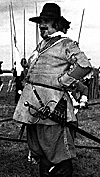 If the Essex Trained Bands were organised as they had been in 1623 (and there is no reason to believe otherwise), the county had 19 companies of foot, 1 troop of heavy horse and two of light horse. [12] The foot companies were generally coterminous with the county's Hundreds, each with an establishment strength of 200 men. [13]
If the Essex Trained Bands were organised as they had been in 1623 (and there is no reason to believe otherwise), the county had 19 companies of foot, 1 troop of heavy horse and two of light horse. [12] The foot companies were generally coterminous with the county's Hundreds, each with an establishment strength of 200 men. [13]
The March to Worcester
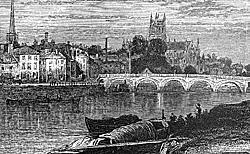 Cromwell decided that the strength of the new Royalist
defences made a direct assault inadvisable. "The enemy hath raised a
fort on this [eastern] side of the town and burnt down divers
outhouses", he wrote to Speaker Lenthall. However, wishing to avoid
the equally unattractive proposition of a lengthy siege, the Lord
General resolved to lure the Royalists out. The country militias, when
they arrived, were to be used to block up the eastern defences of the
city, leaving the experienced regulars of the New Model to do the
business on the south side.
Cromwell decided that the strength of the new Royalist
defences made a direct assault inadvisable. "The enemy hath raised a
fort on this [eastern] side of the town and burnt down divers
outhouses", he wrote to Speaker Lenthall. However, wishing to avoid
the equally unattractive proposition of a lengthy siege, the Lord
General resolved to lure the Royalists out. The country militias, when
they arrived, were to be used to block up the eastern defences of the
city, leaving the experienced regulars of the New Model to do the
business on the south side.
The Battle
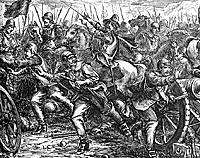 Accounts are, inevitably, confused on the precise details of
the fight. What is plain is that at least one New Model regiment broke
under the assault, and others were driven back. Amazingly, the
Trained Bands stood their ground. Their resistance gave Cromwell
time to bring troops back over the river and come to their aid.
Accounts are, inevitably, confused on the precise details of
the fight. What is plain is that at least one New Model regiment broke
under the assault, and others were driven back. Amazingly, the
Trained Bands stood their ground. Their resistance gave Cromwell
time to bring troops back over the river and come to their aid.
The Aftermath
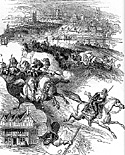 News of the Parliament victory spread rapidly across the country.
Only two days after the battle, an Essex parishioner told Ralph
Josselin that "the Scots were routed". Later that evening he
"confirmed that they [the Royalists] fell out of towne that they were
beate in againe, 4,000 slain, 300 prisoners, our forces did gallantly."
News of the Parliament victory spread rapidly across the country.
Only two days after the battle, an Essex parishioner told Ralph
Josselin that "the Scots were routed". Later that evening he
"confirmed that they [the Royalists] fell out of towne that they were
beate in againe, 4,000 slain, 300 prisoners, our forces did gallantly."
Notes
[2] For example, see C. H. Firth's comments in
Cromwell's Army (London, 1902), pp.l6-7.
[3] It should be stressed that the" comments
do not apply to the London Trained Band. Backed by the immense wealth of the city
guilds, well equipped and regularly drilled, they were far superior to their less fortunate
colleagues in the shires.
[4] Warvick's huge influence in the county
was reflected in his nickname: "The King of Essex." An efficient and conscientious
administrator, the Essex Trained Bands improved significantly following his
appointment as Lord Lieutenant.
[2] Sir Thomas Barrington's regiment,
comprising of the companies of William Turner, Thomas Wilmer, Robert Bevice and John
Savell (PubGc Record Of iice S/P28v129, Pt. 3).
[6] Barrington did not accompany his
regiment on campaign, which was seen as a contributory factor to their misbehaviour
(Histoncal Manuscripts Commission, 7th Report, Appendix, p.55.0).
[7] Calendar of State Papers
Domestic 1644, pp.324 & 326: S/P129/227.
[8] C H. Futh & R S. Rait, eds., Acts and
Ordinances of the Interregnum, Vol. ;., p.472.
[9] The courageous performance of the London
Trained Bands at Newbury in 1643 is the most publicised example.
[10] Principally of Lt. Colonel Henry Farre
and Major Stephen Smith, both units from the middle Hundreds of ESSEX.
[11] Priocipally of Sir Thom Honywood
regiment, from tbe northern Hundreds of Essex.
[12] See Revd. Andrew Clark. "The ESSEX
Territorial Force in 1608, Essex Review, Vol. XVII ( 1908), pp. 110- 115.
[13] Hinckford, a densely populated northern
Hundred, combined with tiny Freshwell to provide three companies. Four smaller
hundreds combined in order to provide the requisite number of troops (Clark. ibid.).
[14] The most notable of these were Lt.
Colonel Henry Farre and Major Stephen Smith.
[15] Peter Young and John Adair, Hastings to
Culloden (Kineton, 1979), p.233. Ian Gentles, The New Model Army (Oxford, 1992),
p.403, believes his strategy was simply to tempt Charles into quitting his stronghold in
Stirling.
[16] PRO S/P28/227. Gentdes (p.405) says
that the rendezvous for East Anglican and southern forces was at St. Albans, but carries
no source for this information.
[17] Ibid. William Harlackenden had formerly
been in the Eastern Association army, as Commissary Ceneral to the Earl of Manchester.
[18] E641/4, pp.1042-4.
[19] Young & Adair, p,241,
[20] Captain Solomon Stebbing's Company
of Honywood Regiment. Essex Record Of fice Q/SBa2/78.
[21] The date of his victory at Dunbar in 1650
was also destined to be the date of his death in 1658.
[22] A. MacFarlane, ea., The Diary of Ralph Josselin (London, 1976), p.256.
[23] Ibid.
[24] The eastern Parliament forces were now
under the direction of Lambert and Harrison.
[25] Quoted in Gentles, p.409.
[26] Quoted in Wilf Emberton, The English
Civil War Day by Day (Stroud, 1995), p.215.
[27] MacFarlane, pp.256-7.
[28] Public Record Office S/P28/227.
[29] Christopher Ellin of Black Notley, Essex,
in Captain Raynor's company.
[30] Henry Levitt of Great Holland,
Essex, in Captain John Maydstone's company.
[31] Thomas White of Witham, Essex, in
Raynor's company.
[32] Essex Record Of fice Q/SBa2/78.
[33] Essex Record Of fice Q/SO1, f..3v.
[34] Colonel Manhews' Regiment. Essex Record Oftice Q/SO1, f 3v.
[35] Ibid.
Back to English Civil War Times No. 52 Table of Contents
Back to English Civil War Times List of Issues
Back to Master Magazine List
© Copyright 1997 by Partizan Press
Other military history articles and gaming articles are available at http://www.magweb.com